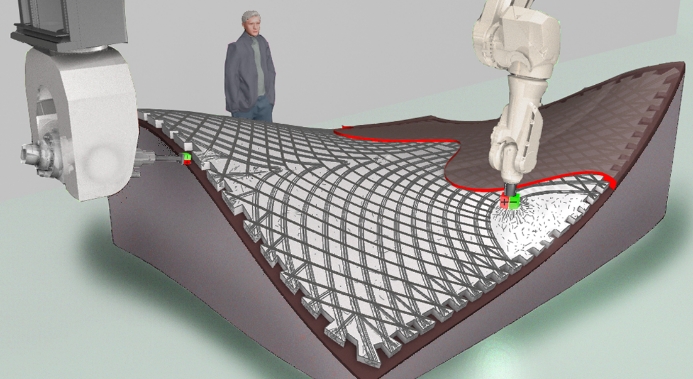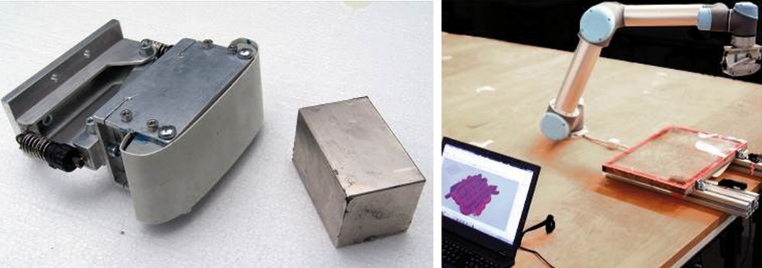The robot-assisted magnetic distribution and orientation of microsteel fibers in UHPFRC (Ultra-High Performance Fiber-Reinforced Concrete) can be used to produce more resource-efficient concrete components [Fig. 1]. Therefore, the research focused on the possibilities of digital and robot based component production on the one hand and the potential of fiber orientation to increase the material efficiency of UHPFRC on the other.
The chosen method for the distribution and orientation of the micro steel fibers in UHPFRC is based on the physical phenomenon of magnetism. Since steel fibers are ferromagnetic, their position in fresh concrete can be specifically changed by using magnetic fields using the novel Magnetic Fiber Alignment (MFA) process.

The aim of the research project was to align the position of the steel fibers in the concrete matrix during the production process according to the force flow and the maxim “form follows force”. This defined arrangement of the fibers in a component is intended to significantly increase the effectiveness of the fiber component used and, in addition to improved workability, lead to a considerable reduction in the fibers used, as a result of which a great potential for savings in ecological and economic resources is provided. The reproducible control of the process, which is ensured by the use of the latest developments in the field of robotic production, will be decisive for an economic, building-practical application of the method.
In particular, the method could be used in the production of modularly constructed plate elements as well as in the highly stressed tooth connections with the aim of achieving a clear increase in performance of these high-performance components.

Extensive preliminary work has been carried out in the field of research on components made of UHPFRC and the magnetic alignment of microsteel fibers. For example, UHPFRC has already been used in projects of the DFG Priority Program 1542 "Concrete Light". In addition, preliminary investigations and tests on the topic of magnetic fiber alignment in UHPFRC have been carried out continuously at ITE since 2014. These preliminary investigations already touched upon central aspects of this research project and provided concrete indications of the expected findings on robot-assisted magnetic alignment and distribution of the microsteel fibers. In particular, the influence of different magnetic fields on the alignment and movement of steel fibers was investigated experimentally in small test specimens. For this purpose, in addition to the UHPC matrix, a medical gel was used, which, as a transparent concrete substitute, allows direct observation of the effects (Fig 3).
Other published preliminary investigations addressed the automation of more complex reinforcement structures. For example, robotic path-based modeling of intersecting fiber strands was investigated as they might be reasonably arranged in the tension zone of plates exposed to biaxial flexural stress. In addition to the investigation of fiber distributions in the surface of thin plates, initial preliminary investigations were also carried out on tooth connections made of UHPFRC.

The project includes experimental, theoretical, numerical, and image analysis methods that are organized sequentially in five work packages:
In WP 1, permanent magnets and three electromagnets are investigated for their suitability for the project. In addition, the magnets will be compared with the ferromagnetic properties of steel fibers. WP 2 aims to develop a digital process chain for controlling the robot-assisted alignment process, which will enable defined reproducibility of the magnetic fiber alignment process. In addition, adaptations for mounting the magnets on the robot arms have to be engineered. In WP 3, different test specimens with steel fibers mono- and biaxially aligned will be produced and tested (Fig 4). In WP 4, fiber mixtures of different fiber materials and their interactions are experimentally investigated. WP 5 finally deals with the development and testing of robot-assisted steel fiber arrangements in the joining area of concrete components for local reinforcement of the load application area (Fig. 5).
In principle, three strategies for a more sustainable use of MSF could be pursued with the MFA process. First, starting from a given fiber content, an increase in ultimate load could be achieved by transferring the individual fibers into a more efficient position and orientation. Second, while maintaining a desired material strength, the fiber content could be reduced through targeted orientation. Third, the higher strengths of the fiber-matrix system achieved by the MFA process provided the opportunity for a leaner design of UHPFRC components and thus for a reduction in matrix and deadweight.
Based on various component tests, it was possible to derive both economic and ecological savings potentials by reducing the fiber content. The average fiber volume fraction saving of 43% led to a reduction in the material cost of the UHPFRC of about 24% and to a reduction in the global warming potential (GWP) of about 25% for the concrete formulation used (see Table 3, p. 18 in this book). The use of recycled microsteel fibers from scrap tire recycling further drastically reduced both the material cost ( about 55%) and GWP (about 49%).
Ledderose, L.; Baghdadi, A.; Kloft, H.: Magnetic Alignment of Microsteel Fibers as Strategy for Reinforcing UHPFRC. In Open Conference Proceedings , Vol. 1, Februar 2022, S. 99-114. Online available at: https://www.tibop.org/ojs/index.php/ocp/issue/view/3/8. (accessed on: 28.01.2022)
Ledderose, L.; Lehmberg, S.; Budelmann, H.; Kloft, H.: Robotergestützte, magnetische Ausrichtung von Mikro‐Stahldrahtfasern in dünnwandigen UHPFRC‐Bauteilen. In: Beton- und Stahlbetonbau, Vol. 1 (2019) Vol. 114, S. 33-42 – DOI: 10.1002/best.201800083
Ledderose, L.; Kloft, H.: Snap-fits made of rein¬forced concrete: From advanced manufacturing to novel applications. In: Adriaenssens, S.; Mueller, C. (Ed.): Creativity in Structural Design – Proc. of the Annual Symp. of the Int. Association of Shell and Spatial Structures (IASS). Boston (USA), 2018. Online available at: https://www.ingentaconnect.com/content/iass/piass/2018/00002018/00000007/art00005 (accessed on: 28.01.2022)
Prof. Dr. Kloft; Dipl. Ing. Lukas Ledderose (M.a.A); Anja Stümmler (Technican)